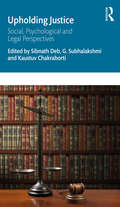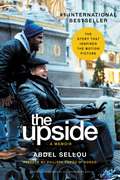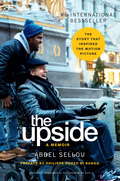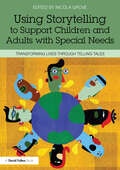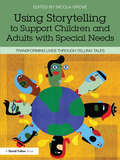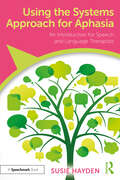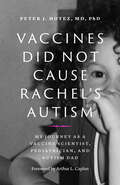- Table View
- List View
Upholding Justice: Social, Psychological and Legal Perspectives
by Sibnath Deb G. Subhalakshmi Kaustuv ChakrabortiThis book critically examines the social, psychological and legal perspectives of justice. It brings together a wide range of contemporary and relevant issues relating to the gross violation of human rights and presents situation-based evidence from firsthand experiences of behavioral, social as well as legal professionals. It deals with themes such as civic and legal rights of children; dignity of the third gender in India; food justice in a welfare state; rights of disabled children; secret marriage of individuals with mental health challenges; and ethics and good governance. Topical and comprehensive, this book will be an excellent read for scholars and researchers of political studies, legal studies, human rights, psychology, behavioral studies, political sociology, sociology, development studies, governance and public policy, and South Asian studies. It will also interest policy makers, NGOs, activists and professionals in the field.
Upholding Justice: Social, Psychological and Legal Perspectives
by Sibnath Deb G. Subhalakshmi Kaustuv ChakrabortiThis book critically examines the social, psychological and legal perspectives of justice. It brings together a wide range of contemporary and relevant issues relating to the gross violation of human rights and presents situation-based evidence from firsthand experiences of behavioral, social as well as legal professionals. It deals with themes such as civic and legal rights of children; dignity of the third gender in India; food justice in a welfare state; rights of disabled children; secret marriage of individuals with mental health challenges; and ethics and good governance. Topical and comprehensive, this book will be an excellent read for scholars and researchers of political studies, legal studies, human rights, psychology, behavioral studies, political sociology, sociology, development studies, governance and public policy, and South Asian studies. It will also interest policy makers, NGOs, activists and professionals in the field.
The Upside: A Memoir (Movie Tie-In Edition)
by Abdel SellouThe acclaimed true story of an aristocrat, a con man, and the friendship that transformed them both, now the inspiration for a major motion picture starring Kevin Hart, Bryan Cranston, and Nicole Kidman. Abdel Sellou and Philippe Pozzo di Borgo were two people marginalized by society: Sellou a wisecracking, unemployed immigrant, just out on parole; Pozzo a man born to wealth and privilege, recently paralyzed from the neck down after a paragliding accident. How they came to help each other, and the unlikely friendship that became a lifeline for them both, is an uplifting story that's now been told and retold around the world. In this bestselling memoir, Sellou shows us the irreverent, real-life character behind Kevin Hart's smiling face. The book takes us from Sellou's childhood spent stealing candy from the local grocery store to his career as a pickpocket and scam artist, to his unexpected employment as a companion for a quadriplegic. Sellou tells his story with a stunning amount of talent, humor, style, and--though he denies that he has any--humility. Originally published as You Changed My Life
The Upside: A Memoir (movie Tie-in Edition)
by Abdel SellouThe story of how Abdel Sellou (a charismatic ex-con) came to be the caretaker of Philippe Pozzo di Borgo (a paralyzed French aristocrat) inspired the award-winning French movie Les Intouchables (2012), which became an international phenomenon and broke records as one of the most successful French movies of all time. Now, The Upside, the American remake of Les Intouchables, starring Kevin Hart, Bryan Cranston, and Nicole Kidman will be released in both the US and the UK in January 2019.Abdel Sellou and Philippe Pozzo di Borgo were two people marginalized by society: Sellou a wisecracking, unemployed immigrant, just out on parole; Pozzo a man born to wealth and privilege, recently paralyzed from the neck down after a paragliding accident. How they came to help each other, and the unlikely friendship that became a lifeline for them both, is an uplifting story that's now been told and retold around the world.
The Upside: A Memoir (Movie Tie-In Edition)
by Abdel SellouYou Saved My Life tells the extraordinary true story of the charming Algerian con-man whose friendship with a disabled French aristocrat inspired the record-breaking hit film, The Intouchables (the American remake starring Kevin Hart and Bryan Cranston coming in 2018). Sellou's fictional reincarnation, Driss, played to critical acclaim by French comedian Omar Sy in the movie Les Intouchables, captured the hearts of millions. Already a bestseller in France and Germany, You Changed My Life shows us the real man behind Sy's edgy charm. The book takes us from his childhood spent stealing candy from the local grocery store, to his career as a pickpocket and scam artist, to his unexpected employment as a companion for a quadriplegic. Sellou has never before divulged the details of his past. In many interviews and documentaries, he has evaded or shrugged off the question of his childhood and his stay in prison, until now. He tells his story with a stunning amount of talent, with humor, style, and-though he denies that he has any-humility. Sellou's idiosyncratic and candidly charming voice is magnificently captured in this memoir, a fact to which his friend Philippe Pozzo di Borgo testifies in his touching preface for the book.
Urville (PDF)
by Gilles TrehinUrville, the capital of a large island province, has a population of nearly 12 million, making it the one of the most significant cities in Europe. It is also entirely imaginary. Gilles Tréhin, an autistic man with exceptional creative talents and an obsession with large cities, conceived and developed Urville over the course of 20 years. He shares his vision in this beautifully illustrated guide to the city, which he renders convincingly real in nearly 300 drawings of different districts of Urville. He describes, in remarkable detail, the architectural styles of its individual buildings and provides historical, geographical, economic and cultural information. This includes historical figures and cultural anecdotes grounded in historical reality - Tréhin accounts for the effects of the Vichy regime, the Second World War and globalisation on his imagined city. This book offers fascinating evidence of and insight into the creative power of the autistic mind and will be of interest to people with autism and without.
Using a Multisensory Environment: A Practical Guide for Teachers
by Paul PaglianoThis book provides teachers and therapists with a user-friendly bank of practical ideas and suggestions to use in the MSE for pupils with profound and multiple learning difficulties. These include equipment and resources that can be used to engineer the environment to promote particular outcomes; a set of photocopiable, fast, easy to complete observation and assessment forms; a selection of practical strategies and methods that can be used in the MSE; and ideas to help teachers integrate environment, assessment and instruction to maximize individual programs.
Using a Multisensory Environment: A Practical Guide for Teachers
by Paul PaglianoThis book provides teachers and therapists with a user-friendly bank of practical ideas and suggestions to use in the MSE for pupils with profound and multiple learning difficulties. These include equipment and resources that can be used to engineer the environment to promote particular outcomes; a set of photocopiable, fast, easy to complete observation and assessment forms; a selection of practical strategies and methods that can be used in the MSE; and ideas to help teachers integrate environment, assessment and instruction to maximize individual programs.
Using Creativity to Address Dyslexia, Dysgraphia, and Dyscalculia: Assessments and Techniques
by Fredricka Reisman Lori SeverinoDesigned to help educators recognize and nurture students with dyslexia, dysgraphia, and dyscalculia, this book guides readers through best practices for using creativity theory and strategies to address the learning challenges for students who have difficulty in acquiring literacy and mathematics content. Offering concrete examples of creativity assessment and pedagogical techniques, chapters are supported by rich appendices providing assessment and screening checklists, time telling objectives, learning trouble spots, a creative approach to teaching place value, and a handy cross-referencing table. Accessible and thorough, this up-to-date guide will help educators develop strategies that acknowledge students’ creative strengths to address learning challenges across the literacy and mathematics curricula.
Using Creativity to Address Dyslexia, Dysgraphia, and Dyscalculia: Assessments and Techniques
by Fredricka Reisman Lori SeverinoDesigned to help educators recognize and nurture students with dyslexia, dysgraphia, and dyscalculia, this book guides readers through best practices for using creativity theory and strategies to address the learning challenges for students who have difficulty in acquiring literacy and mathematics content. Offering concrete examples of creativity assessment and pedagogical techniques, chapters are supported by rich appendices providing assessment and screening checklists, time telling objectives, learning trouble spots, a creative approach to teaching place value, and a handy cross-referencing table. Accessible and thorough, this up-to-date guide will help educators develop strategies that acknowledge students’ creative strengths to address learning challenges across the literacy and mathematics curricula.
Using Drama with Children on the Autism Spectrum: A Resource for Practitioners in Education and Health
by Carmel ConnThe second edition of Using Drama with Children on the Autism Spectrum takes the perspective that support for the learning and development of children should have the purpose of giving them the freedom to be more fully who they are and able to function more effectively as themselves in a wider range of contexts. The focus of this new edition is on learning outcomes as expressed by autistic people, for example, to develop better understandings about the social world and to know how to manage everyday situations more successfully. This practical resource book contains more than 150 activities for use with children aged 5–11 years old. Written for mainstream and special education teachers, speech and language therapists, drama teachers, play workers and creative arts therapists, the book shows how using drama with children across the autism spectrum can provide valuable experiences in being with others and communicating with them in enjoyable ways that support the development of well-being and confidence. In addition, drama is presented as a rich medium for reflecting on everyday social situations and developing children’s understandings about the social world. Complete with case studies, photocopiable resources and step-by-step guidance on how to facilitate drama activities that all children can enjoy, this practical resource will be invaluable for those who are looking for new ways of engaging children on the autism spectrum and their peers. The second edition of this practical resource has been extensively revised, updated and re-focused in line with current practice and thinking.
Using Drama with Children on the Autism Spectrum: A Resource for Practitioners in Education and Health
by Carmel ConnThe second edition of Using Drama with Children on the Autism Spectrum takes the perspective that support for the learning and development of children should have the purpose of giving them the freedom to be more fully who they are and able to function more effectively as themselves in a wider range of contexts. The focus of this new edition is on learning outcomes as expressed by autistic people, for example, to develop better understandings about the social world and to know how to manage everyday situations more successfully. This practical resource book contains more than 150 activities for use with children aged 5–11 years old. Written for mainstream and special education teachers, speech and language therapists, drama teachers, play workers and creative arts therapists, the book shows how using drama with children across the autism spectrum can provide valuable experiences in being with others and communicating with them in enjoyable ways that support the development of well-being and confidence. In addition, drama is presented as a rich medium for reflecting on everyday social situations and developing children’s understandings about the social world. Complete with case studies, photocopiable resources and step-by-step guidance on how to facilitate drama activities that all children can enjoy, this practical resource will be invaluable for those who are looking for new ways of engaging children on the autism spectrum and their peers. The second edition of this practical resource has been extensively revised, updated and re-focused in line with current practice and thinking.
Using Imagination, Mindful Play and Creative Thinking to Support Wellbeing and Resilience in Children (Helping Children to Build Wellbeing and Resilience)
by Deborah PlummerForms part of JKP's 'Helping Children to Improve Wellbeing and Resilience' seriesUsing a model of 'mindfulness play' to help children to achieve wellbeing, this book encourages children to build awareness of their inner and outer worlds. This multidimensional approach, designed and developed by an experienced speech and language therapist, centres on the importance of play activities to build psychological, emotional and social wellbeing and looks into the pivotal role adults play in supporting a child's self-esteem. By promoting the growth of self-esteem in different areas of a child's life, the book shows how adults help children to establish a firm basis of wellbeing from which they can flourish.The accompanying activity booklets that demonstrate the practical application of this approach are:· Helping Children to Manage Transitions· Helping Children to Manage Stress· Helping Children to Manage Friendships· Helping Children to Manage Anger· Helping Children to Build Self-Confidence · Helping Children to Build their Communication SkillsThe strategies in this ebook guide show how imagination, mindfulness and creativity can enhance our daily interactions with children, and the activity books encourage children to build life skills through structured experiences and through experimenting with different ways of thinking and 'being'.
Using Imagination, Mindful Play and Creative Thinking to Support Wellbeing and Resilience in Children (Helping Children to Build Wellbeing and Resilience)
by Deborah PlummerForms part of JKP's 'Helping Children to Improve Wellbeing and Resilience' seriesUsing a model of 'mindfulness play' to help children to achieve wellbeing, this book encourages children to build awareness of their inner and outer worlds. This multidimensional approach, designed and developed by an experienced speech and language therapist, centres on the importance of play activities to build psychological, emotional and social wellbeing and looks into the pivotal role adults play in supporting a child's self-esteem. By promoting the growth of self-esteem in different areas of a child's life, the book shows how adults help children to establish a firm basis of wellbeing from which they can flourish.The accompanying activity booklets that demonstrate the practical application of this approach are:· Helping Children to Manage Transitions· Helping Children to Manage Stress· Helping Children to Manage Friendships· Helping Children to Manage Anger· Helping Children to Build Self-Confidence · Helping Children to Build their Communication SkillsThe strategies in this ebook guide show how imagination, mindfulness and creativity can enhance our daily interactions with children, and the activity books encourage children to build life skills through structured experiences and through experimenting with different ways of thinking and 'being'.
Using Intensive Interaction with a Person with a Social or Communicative Impairment
by Mark Barber Graham FirthThe authors explain clearly how to prepare for, carry out and reflect on the use of Intensive Interaction with a client or family member. A multitude of key questions are addressed. In the final section they consider some of the wider implications of the approach.
Using Literacy to Develop Thinking Skills with Children Aged 7-11
by Paula IleyThese creative off-the-shelf activities will spark children's thinking skills through speaking, listening, reading and writing. Busy teachers wanting to shake up their lessons will find them indispensable. Includes: problem-solving: creative and critical thinking; emotional thinking; questioning skills and plan-do-review formats clear explanation of underpinning theory advice on differentiating activities links to the National Literacy Strategy Framework.
Using Literacy to Develop Thinking Skills with Children Aged 7-11
by Paula IleyThese creative off-the-shelf activities will spark children's thinking skills through speaking, listening, reading and writing. Busy teachers wanting to shake up their lessons will find them indispensable. Includes: problem-solving: creative and critical thinking; emotional thinking; questioning skills and plan-do-review formats clear explanation of underpinning theory advice on differentiating activities links to the National Literacy Strategy Framework.
Using Playful Practice to Communicate with Special Children (nasen spotlight)
by Margaret CorkePlayfulness is important; it creates an alternative space where emotional, cognitive and social dimensions can be explored and tested. This highly practical book explores the endless possibilities of using playful, creative and interactive activities to meaningfully engage with children with multiple learning difficulties or autistic spectrum disorders. The author presents playfulness as ‘an experimental frame of mind’, and encourages practitioners to play with roles, ideas, words, concepts and objects in order to enhance relationships and interventions. By providing accessible steps to playfulness, this text explores some of the contemporary issues surrounding the education of children with severe learning needs, in particular the use of ‘intensive interaction’. This text considers different areas of creative interactive work for practitioners to draw inspiration from, including: Music Interactive Musical Movement Finger Dance Story and Drama Artwork Reflective Circle. The varied array of tried and tested original activities have been devised to encourage the development of social interaction, cognition, play, experimentation and creativity, in particular but not exclusively, for children whose learning needs are more complex. The author also invites teachers working in mainstream, particularly early years and primary education, to investigate the creative possibilities inherent in playfulness and to use the activities in this book to enhance the learning environment. This text offers an abundance of advice, practical strategies and tips for teachers working in special and mainstream early years and primary education. Practitioners such as therapists, care workers, community musicians and creative arts specialists will also find this book useful.
Using Playful Practice to Communicate with Special Children (nasen spotlight)
by Margaret CorkePlayfulness is important; it creates an alternative space where emotional, cognitive and social dimensions can be explored and tested. This highly practical book explores the endless possibilities of using playful, creative and interactive activities to meaningfully engage with children with multiple learning difficulties or autistic spectrum disorders. The author presents playfulness as ‘an experimental frame of mind’, and encourages practitioners to play with roles, ideas, words, concepts and objects in order to enhance relationships and interventions. By providing accessible steps to playfulness, this text explores some of the contemporary issues surrounding the education of children with severe learning needs, in particular the use of ‘intensive interaction’. This text considers different areas of creative interactive work for practitioners to draw inspiration from, including: Music Interactive Musical Movement Finger Dance Story and Drama Artwork Reflective Circle. The varied array of tried and tested original activities have been devised to encourage the development of social interaction, cognition, play, experimentation and creativity, in particular but not exclusively, for children whose learning needs are more complex. The author also invites teachers working in mainstream, particularly early years and primary education, to investigate the creative possibilities inherent in playfulness and to use the activities in this book to enhance the learning environment. This text offers an abundance of advice, practical strategies and tips for teachers working in special and mainstream early years and primary education. Practitioners such as therapists, care workers, community musicians and creative arts specialists will also find this book useful.
Using Storytelling to Support Children and Adults with Special Needs: Transforming lives through telling tales
by Nicola GroveThis innovative and wide-ranging book shows how storytelling can open new worlds for learners with or without special educational needs. With sections that outline both therapeutic and educational approaches, the leading practitioners who contribute to this practical resource draw on their extensive experience, and distil their own approaches for the reader to use as inspiration for their own lessons. Providing a highly accessible combination of theory and practice, the contributors to this book: define their own approach to storytelling describe the principles and theory that underpin their practice demonstrate how they work with different types of story provide extensive case-studies and assessment frameworks for a range of different special needs and age ranges provide some ‘top tips’ for practitioners who want to start using stories in this way. Using Storytelling to Support Children and Adults with Special Needs will be of interest to all education professionals as well as therapists, youth workers, counsellors, and storytellers and theatre practitioners working in special education.
Using Storytelling to Support Children and Adults with Special Needs: Transforming lives through telling tales
by Nicola Grove Nicola GrovesThis innovative and wide-ranging book shows how storytelling can open new worlds for learners with or without special educational needs. With sections that outline both therapeutic and educational approaches, the leading practitioners who contribute to this practical resource draw on their extensive experience, and distil their own approaches for the reader to use as inspiration for their own lessons. Providing a highly accessible combination of theory and practice, the contributors to this book: define their own approach to storytelling describe the principles and theory that underpin their practice demonstrate how they work with different types of story provide extensive case-studies and assessment frameworks for a range of different special needs and age ranges provide some ‘top tips’ for practitioners who want to start using stories in this way. Using Storytelling to Support Children and Adults with Special Needs will be of interest to all education professionals as well as therapists, youth workers, counsellors, and storytellers and theatre practitioners working in special education.
Using the Systems Approach for Aphasia: An Introduction for Speech and Language Therapists
by Susie HaydenUsing the Systems Approach for Aphasia introduces therapists to systems theory, exploring the way in which a holistic method that is already a key part of other health and social care settings can be employed in aphasia therapy. Detailed case studies from the author’s own extensive experience demonstrate how systemic tools can be incorporated into practice, offering practical suggestions for service delivery and caseload management in frequently overloaded community health services. Exploring the treatment process from first encounters, through the management of goals and attainments, to caring for patients after therapy has ended, the book demonstrates a method of delivering therapy in a way that will better serve the people who live with aphasia and their families, as well as the clinician themselves. Key features of this book include: • An accessible overview of systems theory and its use in aphasia therapy. • Consideration of how current popular ideas such as self-management, holistic rehabilitation and compassion focussed therapy can be incorporated to provide the best treatment. • Guidance on when and how to involve families based on case studies. • Case studies throughout to fully illustrate systemic approaches. An essential resource for both students and seasoned clinicians, the theory explored in this book will provide a fresh approach to therapy and new skills for working with people with aphasia and their families.
Using the Systems Approach for Aphasia: An Introduction for Speech and Language Therapists
by Susie HaydenUsing the Systems Approach for Aphasia introduces therapists to systems theory, exploring the way in which a holistic method that is already a key part of other health and social care settings can be employed in aphasia therapy. Detailed case studies from the author’s own extensive experience demonstrate how systemic tools can be incorporated into practice, offering practical suggestions for service delivery and caseload management in frequently overloaded community health services. Exploring the treatment process from first encounters, through the management of goals and attainments, to caring for patients after therapy has ended, the book demonstrates a method of delivering therapy in a way that will better serve the people who live with aphasia and their families, as well as the clinician themselves. Key features of this book include: • An accessible overview of systems theory and its use in aphasia therapy. • Consideration of how current popular ideas such as self-management, holistic rehabilitation and compassion focussed therapy can be incorporated to provide the best treatment. • Guidance on when and how to involve families based on case studies. • Case studies throughout to fully illustrate systemic approaches. An essential resource for both students and seasoned clinicians, the theory explored in this book will provide a fresh approach to therapy and new skills for working with people with aphasia and their families.
Vaccines Did Not Cause Rachel's Autism: My Journey as a Vaccine Scientist, Pediatrician, and Autism Dad
by Peter J. HotezIn 1994, Peter J. Hotez's nineteen-month-old daughter, Rachel, was diagnosed with autism. Dr. Hotez, a pediatrician-scientist who develops vaccines for neglected tropical diseases affecting the world's poorest people, became troubled by the decades-long rise of the influential anti-vaccine community and their inescapable narrative around childhood vaccines and autism. The alleged link between the two was first espoused in a fraudulent scientific paper, long since retracted, but the story shows no signs of letting up. As a result, we've seen deadly and disabling outbreaks of vaccine-preventable diseases around the country, and Texas, where Hotez lives, is at particular risk.In Vaccines Did Not Cause Rachel's Autism, Hotez draws on his experiences as a pediatrician, vaccine scientist, and father of an autistic child. Outlining the arguments on both sides of the debate, he examines the science that refutes the concerns of the anti-vaccine movement, debunks current conspiracy theories alleging a cover-up by the CDC, and critiques the scientific community's failure to effectively communicate the facts about vaccines and autism to the general public, all while sharing his very personal story of raising a now-adult daughter with autism.A uniquely authoritative account, this important book persuasively provides evidence for the genetic basis of autism and illustrates how the neurodevelopmental pathways of autism are under way before birth. Dr. Hotez reminds readers of the many victories of vaccines over disease while warning about the growing dangers of the anti-vaccine movement, especially in the United States and Europe. A former US Science Envoy for the Department of State, he also explains what's at stake if the movement continues to gain ground. Opening with a foreword by leading medical ethicist Arthur L. Caplan, this book is a must-read for parent groups, child advocates, teachers, health-care providers, government policymakers, health and science policy experts, and anyone caring for a family member or friend with autism."When Peter Hotez;¢;‚¬;€?an erudite, highly trained scientist who is a true hero for his work in saving the world's poor and downtrodden;¢;‚¬;€?shares his knowledge and clinical insights along with his parental experience, when his beliefs in the value of what he does are put to the test of a life guiding his own child's challenges, then you must pay attention. You should. This book brings to an end the link between autism and vaccination.";¢;‚¬;€?from the foreword by Arthur L. Caplan, NYU School of Medicine
Vaccines Did Not Cause Rachel's Autism: My Journey as a Vaccine Scientist, Pediatrician, and Autism Dad
by Peter J. HotezIn 1994, Peter J. Hotez's nineteen-month-old daughter, Rachel, was diagnosed with autism. Dr. Hotez, a pediatrician-scientist who develops vaccines for neglected tropical diseases affecting the world's poorest people, became troubled by the decades-long rise of the influential anti-vaccine community and their inescapable narrative around childhood vaccines and autism. The alleged link between the two was first espoused in a fraudulent scientific paper, long since retracted, but the story shows no signs of letting up. As a result, we've seen deadly and disabling outbreaks of vaccine-preventable diseases around the country, and Texas, where Hotez lives, is at particular risk.In Vaccines Did Not Cause Rachel's Autism, Hotez draws on his experiences as a pediatrician, vaccine scientist, and father of an autistic child. Outlining the arguments on both sides of the debate, he examines the science that refutes the concerns of the anti-vaccine movement, debunks current conspiracy theories alleging a cover-up by the CDC, and critiques the scientific community's failure to effectively communicate the facts about vaccines and autism to the general public, all while sharing his very personal story of raising a now-adult daughter with autism.A uniquely authoritative account, this important book persuasively provides evidence for the genetic basis of autism and illustrates how the neurodevelopmental pathways of autism are under way before birth. Dr. Hotez reminds readers of the many victories of vaccines over disease while warning about the growing dangers of the anti-vaccine movement, especially in the United States and Europe. A former US Science Envoy for the Department of State, he also explains what's at stake if the movement continues to gain ground. Opening with a foreword by leading medical ethicist Arthur L. Caplan, this book is a must-read for parent groups, child advocates, teachers, health-care providers, government policymakers, health and science policy experts, and anyone caring for a family member or friend with autism."When Peter Hotez;¢;‚¬;€?an erudite, highly trained scientist who is a true hero for his work in saving the world's poor and downtrodden;¢;‚¬;€?shares his knowledge and clinical insights along with his parental experience, when his beliefs in the value of what he does are put to the test of a life guiding his own child's challenges, then you must pay attention. You should. This book brings to an end the link between autism and vaccination.";¢;‚¬;€?from the foreword by Arthur L. Caplan, NYU School of Medicine
